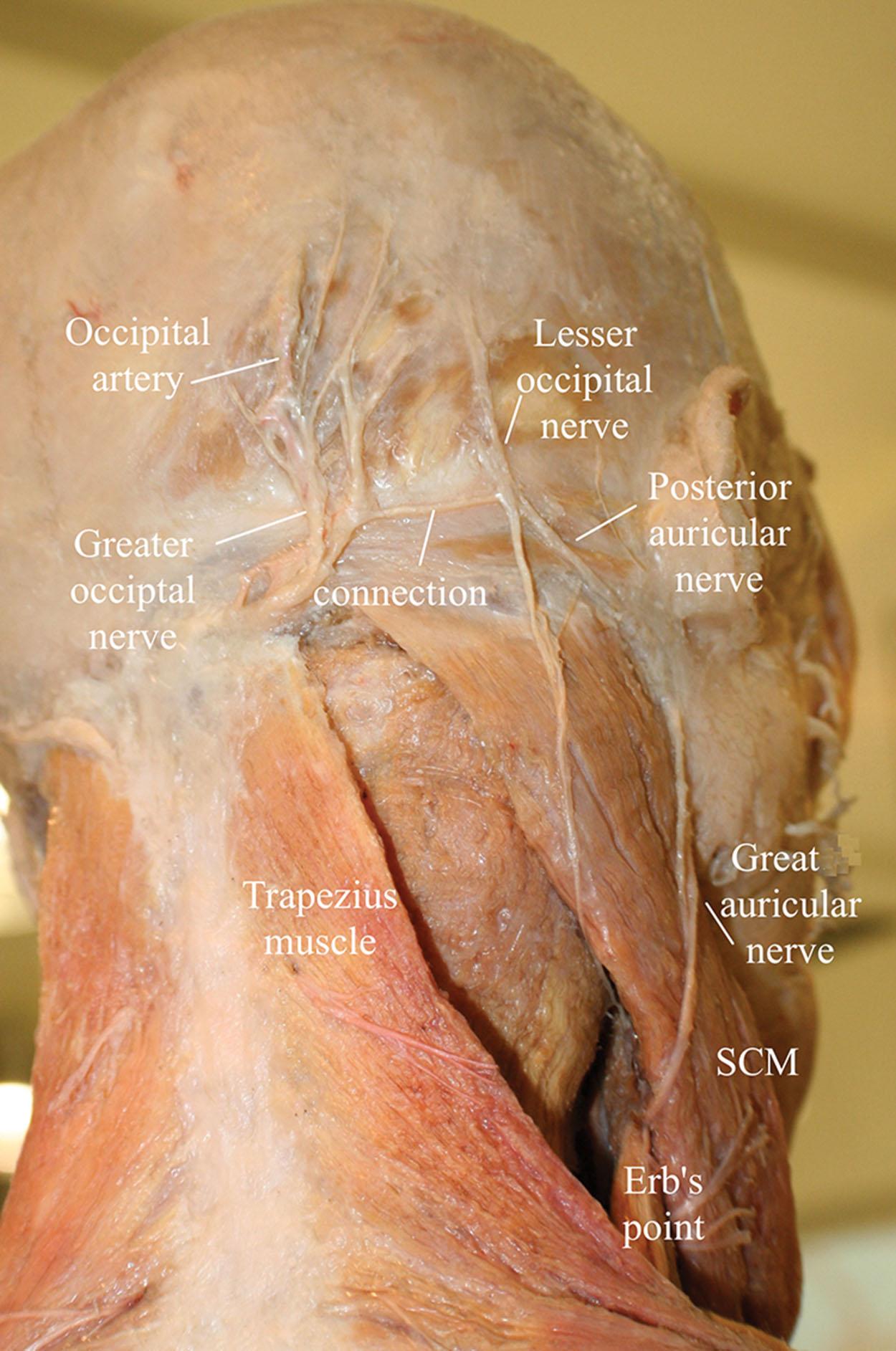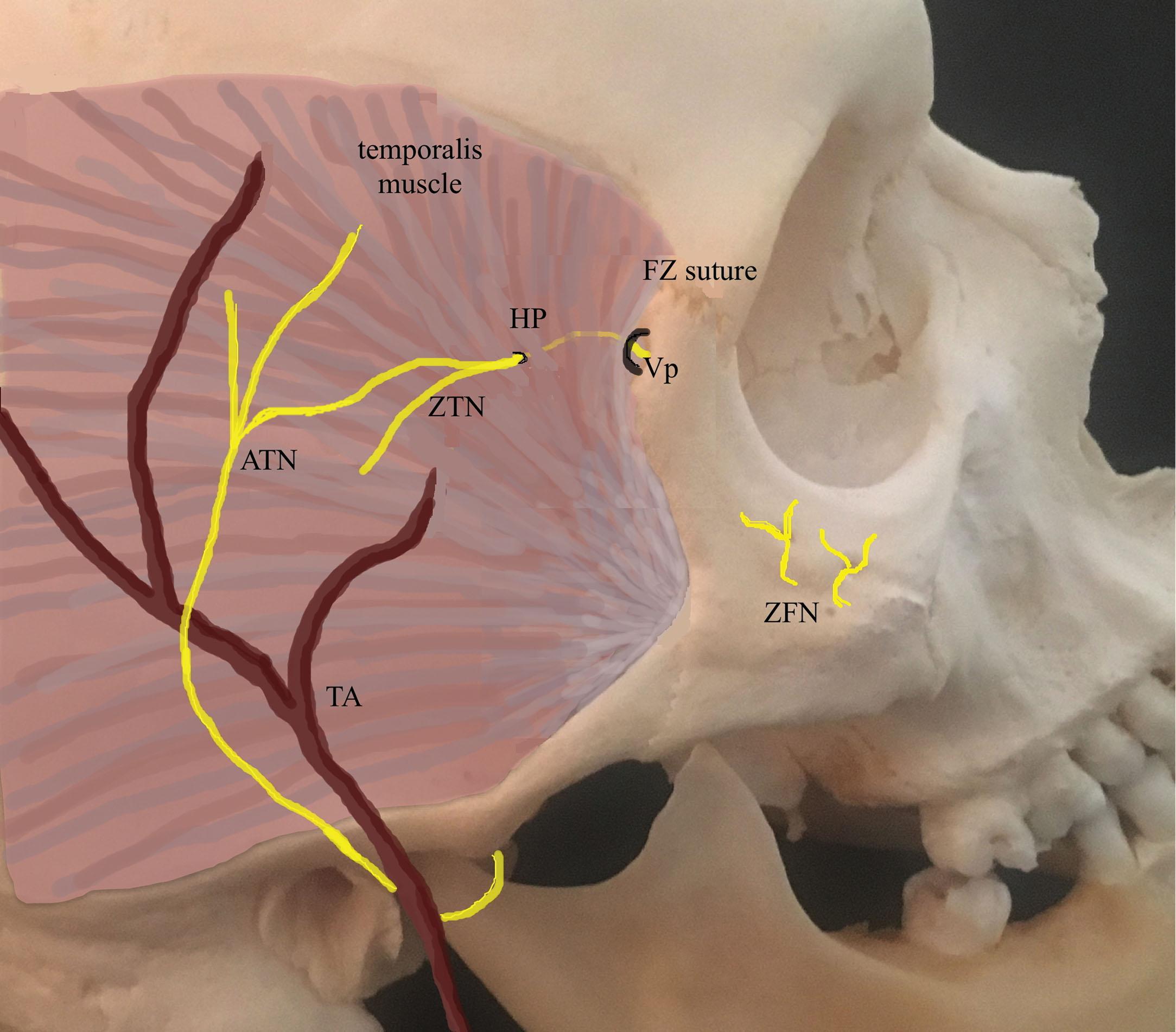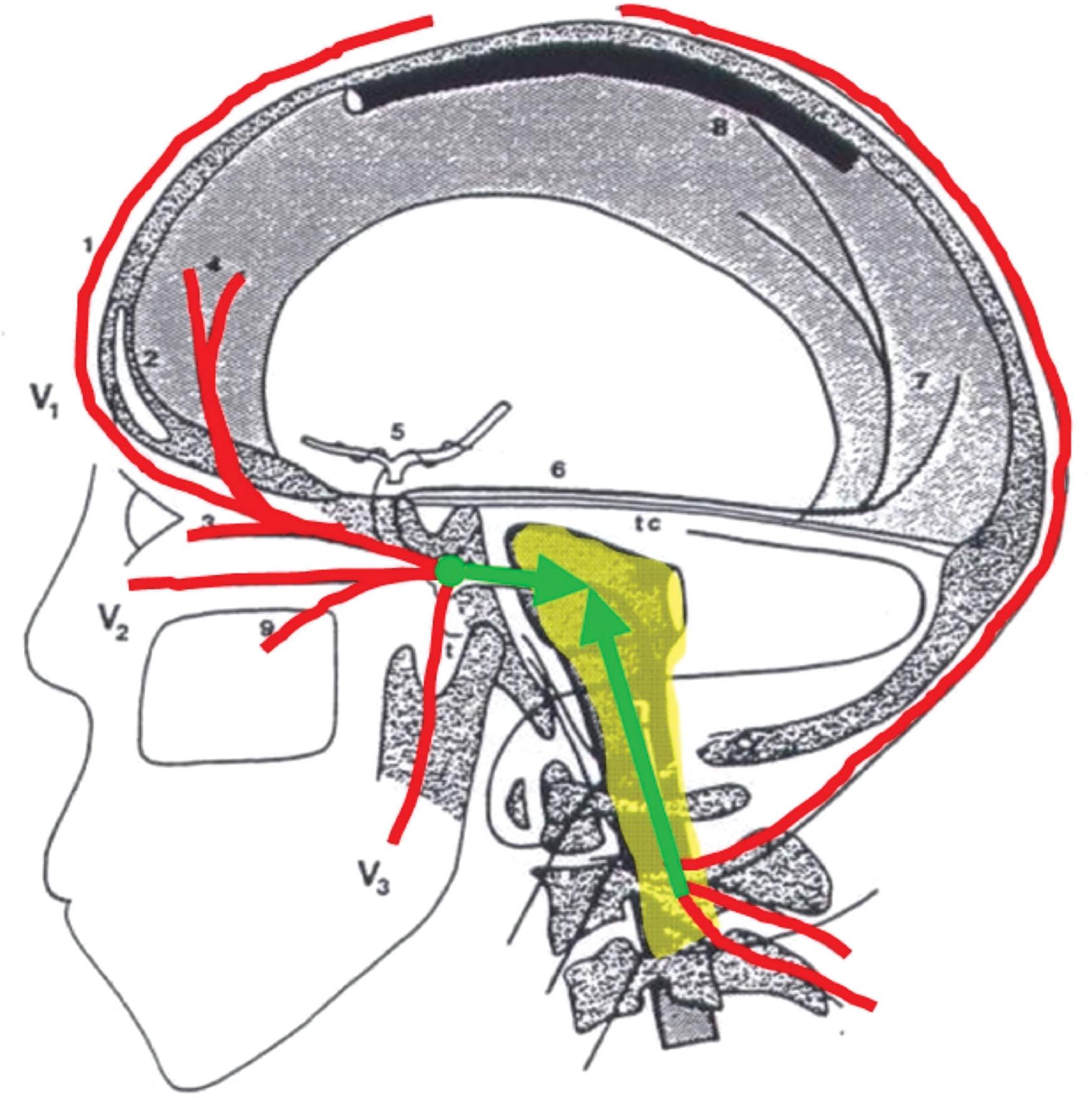Physical Address
304 North Cardinal St.
Dorchester Center, MA 02124
Craniofacial neuralgias are a common source of chronic pain. They can be primary or secondary to insults such as trauma, surgery, tumors, or infections. Occipital neuralgia was one of the first cranial neuralgias to be routinely treated with peripheral nerve blocks. Reports as early as 1969 showed that patients responded well to occipital nerve blocks. Today, occipital nerve blocks are often used in the management of headache disorders. More recently, interventions targeting other areas such as the supraorbital nerve, infraorbital nerve, auriculotemporal nerve, and sphenopalatine nerve have become a more common practice in the management of head, neck, and face neuropathic pain. Craniofacial neuralgias do not always present in the classical sense of dysesthesias, including burning or tingling. They may present in terms of ache-like referral patterns rather than radiations; hence, they are often lumped into the headache categorization of the migraine syndrome. Peripheral nerve injections can play a critical role in the diagnosis and management of headaches and face pain.
Identifying the exact source of pain still remains a challenge. A simple pathway of initiation might be teased out from history, but a more complex problem, beyond the confines of a single nerve distribution, is usually present. If the patient is seen early during the pain problem, a peripheral nerve entrapment may be identified, and diagnostic nerve blocks with hydrodissection under X-ray or ultrasound may prove therapeutic. Given the increasing complexity over time, the history usually provides an anatomic target for neuromodulation rather than a pathway for which long-term benefit is seen with targeted injections. Targeted use of peripheral implantable stimulation may be indicated. It seems too often that patients are treated systemically (pharmacologically) and not with targeted care. Over the time course of their pain journey, the problem may blossom into a wider array of symptoms through central sensitization or other mechanisms.
Instead of using neuromodulation as a treatment of last resort, this option should be considered as part of targeted therapy earlier on. If a patient has repeated short-term success with injections, neuromodulation may be a better long-term option than frequent injection therapy. Well thought-out somatic and sympathetic blocks are rarely negative diagnostically; but they also have a very low probability of long-term benefit when treating chronic head neck and face pain. For this reason, the use of implanted neuromodulation electrodes is a very logical transition for successful long-term pain control.
An understanding of the potential sensory and motor pathways of the head, neck, and face is vitally important to applying craniofacial neuromodulation. This includes understanding the anatomic pathways and the interactions of various craniofacial neural structures and giving forethought to how the leads and energy source can be implanted surgically.
The sensory innervation of the head, neck, and face includes pathways from the cervical spine as well as the cranial nerves. The upper cervical nerve roots of C2, C3, and C4 (and some of C5) are important for sensory afferent pathways. Sensory information come from both the posterior primary division and the anterior primary division. Distally, the posterior primary division develops into the many named occipital nerves––the greater occipital, lesser occipital, and third occipital nerves––all of which may be interconnected ( Fig. 32.1 ). The anterior primary division forms the superficial cervical plexus, which includes the great auricular and posterior auricular nerves. Both sets of nerves spread across the head and neck towards the face. Some accounts suggest peripheral connectivity with the trigeminal branches.

The cranial nerve involvement is most predominantly along the Gasserian ganglion or the fifth cranial nerve. All three divisions of the trigeminal nerve may be involved and can refer pain to the occipital region. The auriculotemporal branch of the third division of the trigeminal nerve may overlap with the peripheral branches of the facial nerve (seventh cranial nerve) ( Fig. 32.2 ).

Superficially, the sympathetic and parasympathetic nerves may also have a part to play in the pain and symptom complex of head, neck, and face pain. The International Headache Society has described a phenomenon called SUNCT: a syndrome associated with ipsilateral tearing, conjunctival injection, a drooping eyelid, and pulsating periorbital pain. These also may be signs of sympathetic dysfunction in other chronic pain syndromes.
Centrally, beyond the ease of simple surgical access, is the coalescence of the pathways of the upper cervical nerves and the trigeminal nerves called the nucleus caudalis or the cervicotrigeminal relay ( Fig. 32.3 ). From this convergence, sensation of pain and temperature travel to the thalamus and then to the cortex.

An understanding of the associated musculature and their interactions with the nerves, such as possible entrapments, is important in diagnosis and planned treatment ( Table 32.1 ).
| MUSCLE | ORIGIN | INSERTION | ACTION | NERVE | ARTERY |
|---|---|---|---|---|---|
| Frontalis | Epicramial aponeurosis | Skin of eyebrow + forehead | Elevates eyebrow, wrinkles forehead | CN 7 | Supraortibal, Supratrochlear |
| Auricularis Superior | Lateral epicranial aponeurosis | Upperauricle | Elevates ear | CN 7 - Temporal branch | Superficial temporalartery |
| Auricularis Anterior | Temporal fascio | Heltx of the ear | Puls ear up and forward | CN 7 - Temporal branch | Superficial temporalartery |
| Auricularis Posterior | Mastoid Process | Covexity of concha of ear | Puls ear up and back | CN 7 - Posterior auricular branch | Posterior auricular artery |
| Occipitalis | Superior nuchaline | Galea apo neurotica | Elevates eyebrow, wrinkles forehead | CN 7 - Posterior auricular branch | Occipitalartery |
| Trapezius | Occipial protuberance; Spinous process C1-7; Spinous processes T1-4; Spinous processes T5-T12 | Lateral 1/3 clavicle; Medial acromion; Upper crest of scapular spine | Reteraction, superior rotation, elevation, depression of scapula | CN 11C3, C4 | Transverse cervicalartery |
| Temporalis | Fossa of temporalis | Coronoid process of mandible and the anterior surface of the ramus of the mandible | Elevate mandibleRetract mandible | CN V3 - Anterior and Posterior Deep Temporal nerves | Anterior and posterior deep temporal artestes |
| Sternocleidomastoid | Sternalhead; Clavicularhead | Mastoid process; lateral superior muchaline | Ipsiateral head InclineContraiaterl head rotation | CN 9Sensory C2, C3 | Superficial temporalartery |
| Splenius Capitus | Ligamentum nuchaeSpinous process C7-T6 | Mastoid process; lateral superior muchaline | Ipsiateral head rotationExtension/lateral flexion of the cervcial spine | PPR C2-6 | Deep cervical; posterior intercostals |
| Splenius Cervicis | Ligamentum nuchaeSpinous process C7-T6 | Posterior transverse processes tubercles of C1-C3 | Ipsiateral head rotationExtension/lateral flexion of the cervcial spine | PPR C2-6 | Deep cervical; posterior intercostals |
| Levator Scapulae | Transverse process of C1-4 | Superior/medial angle of scapula | Ipsiateral head inclineElevate scapula | Dorsal scapular nerve (C5)C3, C4 spinalin branches | Dorsalscapularartery |
| Rhomboid minor | Spinous process C7, T1 | Medialscapula interior to spine | Stabilization, reteraction, elevation, internal rotation scapula | Dorsal scapular nerve (C4,5) | Dorsalscapularartery |
| Rhomboid major | Spinous process T2-T5 | Medialscapula interior to spine | Stabilization, reteraction, elevation, internal rotation scapula | Dorsal scapular nerve (C4,5) | Dorsalscapularartery |
| Serratus posterior superior | Spinous process C7-T3 | Superior margin ribs 2,3,4 | Elevate ribs | Ventral rami of T1-4 | Posterior intercostals |
| Longissimus thoracis | Sacrum, Ilac crest, SP lumbarvert; TP lower thoracicvert | Ribs 2-12; TP thoracicvert | Extension trunk, neck, headLateral flexion trunk, neck, head | Dorsalrami C1-S1 | Deep cervical; poserior intercostals; subcostals; lumbar |
| Longissimus cervicis | TP upper T4,5 | Posterior tubercies TP of C2-6 | Biateral extension of head, neckLateral flexion of head, neck | Dorsalrami C1-S1 | Deep cervical; poserior intercostals; subcostals; lumbar |
| Longissimus captius | TP upper T4,5Articular process C5,6,7 | Posterior margin of mastoid process | Biateral extension of head, neckLateral flexion of head, neck | Dorsalrami C1-S1 | Deep cervical; poserior intercostals; subcostals; lumbar |
| Iliocostalis (thoracic) | Medial ribs 6-12 | TP C4,5,6 + angle ribs 1-6 | Extension, Abduction, rotation of Tspine | Dorsalrami T1-12 | Deep cervical; poserior intercostals; subcostals |
| Intercostalis (cervical) | Angles ribs 1-6 | TP C4,5,6 | Extension, Abduction, rotation of Cspine | Dorsalrami of upper T mm | Deep cervical; poserior intercostals; subcostals |
| Anterior Scalene | Anterior tubercles TP C3-6 | Scalene tubercle 1st rfb | Elevation of ribs Flexion, indination Cspine | Brachial plexus (C5-7) | Ascending cervical artery; branch of thyrocervical trunk |
| Middle scalene | Posterior tubercles TP C2-7 | Upper surface 1st rfb | Elevation of ribsFlexion, indination Cspine | Brachial plexus (C3-8) | Ascending cervical artery |
| Posterior scalene | Posterior tubercles TP C5-7 | Lateral surface of 2nd rfb | Elevation of ribsFlexion, indination Cspine | Brachial plexus (C3-8) | Ascending cervical artery |
| Spinalis cervicis | SP C6,7 | SP of upper Cspine | Extend Cspine | Dorsal rami C2-6 | Deep cervical; posterior intercostals |
| Semispinalis capitis | TP/articular process C3-T6 | Posterior occipital bone below superior nuchal line | Extension C/Tspine, headLateral flexion of C/Tspine, head | Dorsl rami C1-T12 | Deep cervical; posterior intercostals; subcostals; lumbar |
| Multifidi | TP Cspine | SP superior vertebrae | Extension; Ipsiateral flexionContraiateral rotation | Dorsl rami C1-S1 | Deep cervical; posterior intercostals; subcostals; lumbar |
| Interspinalis cervicis | Upper SP Cervical | Lower SP Cervical | Extension | Dorsl rami C1-S1 | Deep cervical; posterior intercostals; subcostals; lumbar |
| Intertransversarii cervicis posteriores | Upper TP C2-T1 | Lower TP C1-7 | Lateral neck flexion | Dorsl rami of Cspine | Deep cervical; posterior intercostals; subcostals |
| Rectus capitis posterior major | Posterior tubercle Axis SP | Lateral occiput Inferior nuchal line | Extension Ipsiateral rotation | Suboccipital nerve | Occipitalartery |
| Rectus capitis posterior minor | Posterior tubercle Atlas SP | Medial occiput Inferior nuchal line | Extension | Suboccipital nerve | Occipitalartery |
| Obliquus capitais inferior * only capitais to not attach head | Apex of spinous process of C2 | Transverse process of C1 | Rotates C1 (and there by head) | Suboccipital nerve | Occipitalartery |
| Obliquus capitis superior | Transverse process of C1 | Lateral aspect of inferior nuchal line | Extend the head Ipsiateral flexion | Suboccipital nerve | Occipitalartery |
* Important in Proprioception; High density of Golgi organs and muscle spindles
The clinical presentation of craniofacial pain can be complicated, and a detailed history should be sought, looking for a possible root cause. Too often, these patients are seen by an experienced interventional pain physician after many years into a journey of treatment for a primary head, neck, and facial pain disorder. The term “primary” is paramount, as it is not felt to be secondary to a known cause. Some remain localized neuralgias and may be secondary to an inciting event. In those instances, targeted care by an interventionalist may solve the problem. Fluid dissection of small entrapments or treatment with cryoneuroablation or radiofrequency energy may be indicated. However, the specifics tend to become blurred with time, and characterization often fits a primary headache disorder.
Most often, these patients carry a primary diagnosis of “migraine,” which itself is generally a term representing a syndrome of symptoms rather than a clear diagnosis or cause. This diagnosis is often self-diagnosed or perpetuated along a pathway to provide a pharmacologic basis of treatment. All too often, these patients present to the interventionalist after years of failed therapies. Once the pharmacologic cascade of treatment begins, the patients may have limited or fleeting benefits with the receptor-driven treatment and are seeking what they perceive as atypical treatment approaches––simple well-placed nerve injections by a skilled interventionalist. Sometimes they have just realized that the medication approach(es) used continue to provide little benefit despite various recipes and combinations of use. Sometimes they cannot tolerate the side effects and seek alternatives sooner. Sometimes they find some distinct benefit but are limited by side effects. There is often a trade-off between pain reduction and side effects such as decreased concentration. Very rarely do patients seem to present prior to an extensive track record of failed traditional medical management. What we as interventionalists may think of as basic care and diagnostic work-up are often not even considered.
Peripheral nerve stimulation (PNS) is indicated for peripheral mononeuropathies and is used as a treatment of last resort. The sources of pain should be defined with a rational expectation of the benefit that the implanted neuromodulation would be expected to provide. Some standardized approaches have been used to treat common disorders, such as the approaches for occipital stimulation and combined occipital and supraorbital stimulation. However, common craniofacial headache disorders are often without clear anatomic explanation at the time of evaluation, and thus a multifactorial approach needs to be taken to optimize success. Studies have shown that traditional medical management for intractable chronic pain such as refractory migraine seems to have a much lower bar to success than implantable neuromodulation. Measures of pain-free response in medication efficacy look at sustained relief of only 2 to 24 hours. Other measures of efficacy are deemed positive with 3 or 4 resolved days of pain per month. That could be translated to as low as 10% effectiveness for someone in chronic daily pain. A meta-analysis by Shauly et al. suggested positive benefits with occipital nerve blocks, showing a pooled difference of 3.6 fewer headache days per month. Although not directly comparable, implantable neurostimulation is only felt to be successful if there is at least a 50% reduction in pain. This measure itself, “percent reduction in pain,” is quite subjective. A subjective percentage improvement is based on function, mood, concentration, and social interaction, as well as pain, which is where most of the respondents questioned in clinical practice report 80% to 90% improvement.
There is strong evidence supporting chronic pain control through the use of neuromodulation. The Gate Control Theory of pain published by Melzack and Wall in 1965 revolutionized the concept of introducing electric currents to inhibit painful signals. Neuromodulation introduces electric current, stimulating wide–dynamic range neurons, utilizing its powerful inhibitory effect on painful stimuli caused by A-delta fibers. The static electrical effects of many neuromodulation devices do not adjust for positional variability. However, some neuromodulation companies have developed an adaptable device using an accelerometer for dynamic adaptability to positional changes.
High cervical spinal cord stimulation (SCS) has been used for many decades in an attempt to treat complex neuropathic cephalgias. This was first seen with monopolar single electrodes. Next were attempts at retrograde C0/C1 paddle leads. More recently has been the application of high cervical central lead placements for chronic headaches.
Become a Clinical Tree membership for Full access and enjoy Unlimited articles
If you are a member. Log in here